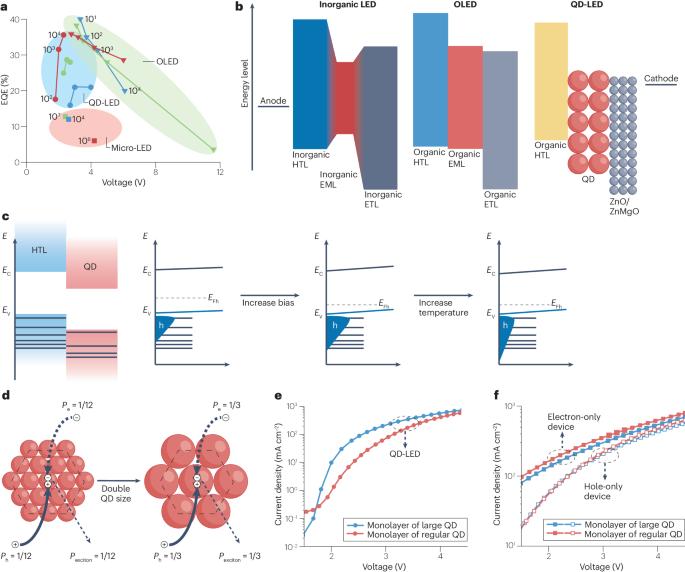Advances in understanding quantum dot light-emitting diodes
引用次数: 0
Abstract
Quantum dot light-emitting diodes (QD-LEDs) are attractive for display and lighting applications owing to their high colour rendering index, their low-cost solution processability and their ability to achieve simultaneous high brightness and near-unity internal quantum efficiency at low voltages. Since 1994, tremendous progress has been made in improving the external quantum efficiency and lifetimes of QD-LEDs, and there has been growing understanding of the operational and degradation mechanisms. However, there are still critical problems that remain to be clarified, such as the origin of positive ageing and the role of zinc oxide nanoparticles in achieving high performance. In this Review, we analyse the key factors influencing voltage, internal quantum and photon out-coupling efficiencies of QD-LEDs. We point out the issues related to cadmium-free quantum dots and short-lifetime blue QD-LEDs. Finally, we clarify the challenges and summarize the latest progress in commercializing QD-LEDs. Quantum dot light-emitting diodes (QD-LEDs) are attractive for display and lighting applications. Precise understanding of their operational and degradation mechanisms will greatly promote the commercialization of this technology. This Review summarizes the key understanding and remaining challenges of QD-LEDs.

了解量子点发光二极管的进展
量子点发光二极管(QD-LED)具有高显色指数、低成本解决方案加工能力以及在低电压下同时实现高亮度和近乎统一的内部量子效率的能力,因此在显示和照明应用中极具吸引力。自 1994 年以来,在提高 QD-LED 的外部量子效率和寿命方面取得了巨大进步,人们对其运行和退化机制的了解也在不断加深。然而,仍有一些关键问题有待澄清,如正老化的起源和氧化锌纳米粒子在实现高性能方面的作用。在本综述中,我们分析了影响 QD-LED 的电压、内部量子和光子外耦合效率的关键因素。我们指出了与无镉量子点和短寿命蓝色 QD-LED 有关的问题。最后,我们阐明了在实现 QD-LED 商业化方面所面临的挑战并总结了最新进展。量子点发光二极管(QD-LED)在显示和照明应用中极具吸引力。准确了解其运行和降解机制将极大地促进该技术的商业化。本综述总结了对量子点发光二极管的主要认识和仍然面临的挑战。
本文章由计算机程序翻译,如有差异,请以英文原文为准。
求助全文
约1分钟内获得全文
求助全文

 求助内容:
求助内容: 应助结果提醒方式:
应助结果提醒方式:


